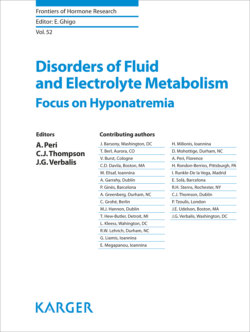Читать книгу Disorders of Fluid and Electrolyte Metabolism - Группа авторов - Страница 37
На сайте Литреса книга снята с продажи.
Decreased EABV
ОглавлениеEABV can be conceptualized as the arterial blood volume that effectively perfuses organs. EABV cannot be directly measured but it can be inferred from other physiological measurements (e.g., plasma renin activity, plasma aldosterone concentration, urine sodium concentration, fractional excretion of sodium, urea or uric acid) [24]. Changes in EABV normally vary in parallel with changes in the ECF volume. This is the mechanism primarily responsible for hypovolemic hyponatremia. However, EABV and ECF can become uncoupled in certain disease states. In these disorders, even in the presence of increased ECF volume, EABV is decreased because of either pump failure (e.g., congestive heart failure) or decreased peripheral resistance (e.g., liver cirrhosis), both causing decreased organ perfusion [23, 24]. This is the mechanism primarily responsible for hypervolemic hyponatremias (Fig. 2c).
